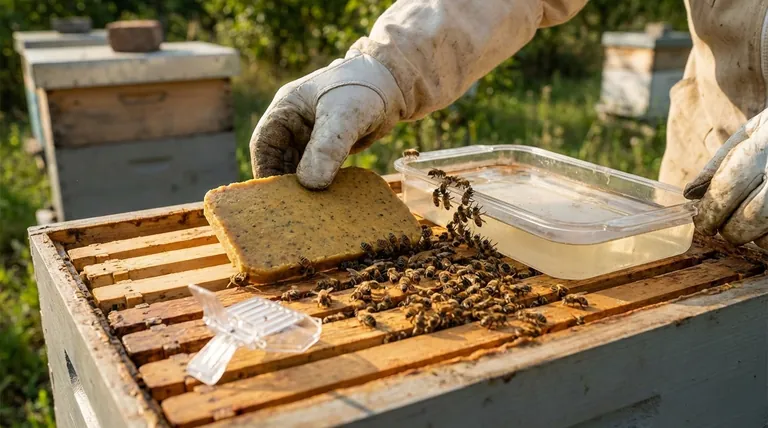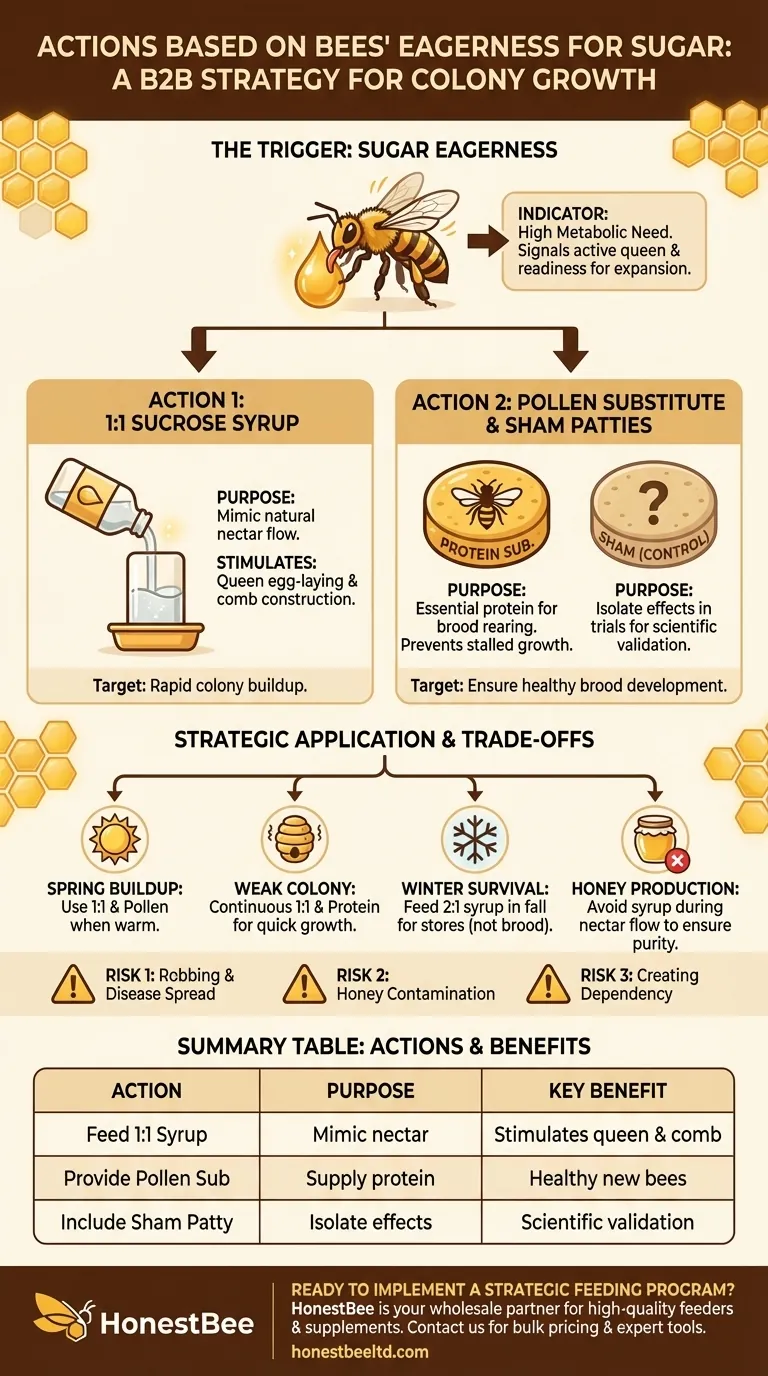Based on the bees' eagerness to consume sugar, a series of supplemental feedings were initiated to stimulate colony growth. The primary action was feeding the colony ½ gallon of 1:1 sucrose syrup, which was then followed by providing both a pollen substitute and control "sham" patties.
A honeybee colony's strong interest in sugar syrup is a key indicator that it is in a growth-oriented state. Beekeepers and researchers leverage this behavior by providing specific nutritional supplements to strategically encourage brood rearing and accelerate the expansion of the colony's population.

The Rationale Behind Supplemental Feeding
Observing a colony's feeding behavior is a fundamental diagnostic tool. Their enthusiasm for a sugar source is not just a sign of hunger; it's a signal that the colony's internal processes are active and ready for expansion. This is the trigger for strategic intervention.
Interpreting Eagerness for Sugar
When bees aggressively consume sugar syrup, it indicates a high metabolic need within the hive. This is typically driven by two factors: a lack of incoming natural nectar and an active queen laying a significant number of eggs. The colony requires a high volume of carbohydrates to feed the existing population and to produce the beeswax needed for new comb.
The Role of 1:1 Sucrose Syrup
The first action was to provide a 1:1 sucrose syrup (equal parts sugar and water). This specific ratio is important because it closely mimics the consistency of natural nectar.
This thin syrup acts as a stimulant. It signals to the queen and the nurse bees that a strong "nectar flow" is on, prompting the queen to increase her egg-laying rate and encouraging workers to begin or expand comb construction. The goal here is not just to provide food, but to trigger a biological imperative for colony buildup.
The Necessity of Protein
Syrup alone is insufficient for population growth. While carbohydrates from sugar provide energy, bees require protein and lipids to raise new bees (brood). This is why the second step was feeding a pollen substitute.
Pollen is the bees' natural protein source. By providing a substitute, beekeepers ensure the nurse bees have the essential nutrients to feed the developing larvae. Without adequate protein, a queen may lay many eggs, but the colony will be unable to raise them to adulthood, stalling population growth.
The Purpose of Sham Patties
The mention of sham patties indicates this action was part of a structured trial or experiment. A sham patty is a control—it looks and feels like the real pollen substitute patty but lacks the key nutritional ingredients.
Including a sham patty allows researchers to isolate the effects of the nutritional supplement. By comparing the colony's development with a real pollen patty versus the sham, they can definitively conclude whether the supplement itself, and not just the act of feeding, caused the observed changes.
Understanding the Trade-offs of Feeding
Supplemental feeding is a powerful tool, but it is not without risks and required considerations. Its application must be deliberate and timed correctly.
Risk of Robbing and Disease
An open food source like a feeder can attract bees from other, weaker colonies. This can initiate "robbing," where foreign bees attempt to steal the food, leading to fighting, stress, and the potential spread of pests and diseases between hives.
Impact on Honey Purity
Feeding syrup while bees are actively producing honey intended for harvest is a critical error. Bees will store the processed syrup in the honeycomb just as they would nectar, contaminating the final product. True honey must be derived purely from floral nectar. Therefore, all feeding must cease before honey supers are added to the hive.
Creating Dependency
Constant, unnecessary feeding can disrupt a colony's natural foraging rhythms. It is a temporary intervention designed to bridge a nutritional gap or stimulate growth during specific periods, such as early spring, not a permanent meal plan.
Applying This Strategy to Your Colony
Understanding the principles behind this feeding sequence allows you to apply it with precision. Your decision to feed should be based on a clear objective.
- If your primary focus is rapid spring buildup: Use 1:1 syrup and a pollen patty when the weather warms but natural pollen and nectar are still scarce.
- If your primary focus is helping a new or weak colony: Provide continuous 1:1 syrup and protein to give them the resources to draw comb and raise the first generations of brood quickly.
- If your primary focus is ensuring winter survival: Feed a heavy 2:1 syrup (two parts sugar to one part water) in the fall to help bees build up their winter food stores, not to stimulate brood rearing.
- If your primary focus is pure honey production: Avoid feeding syrup entirely during the main nectar flow to ensure the integrity and quality of your harvest.
Ultimately, viewing supplemental feeding as a precise tool, rather than a routine, empowers you to guide your colony's development and ensure its long-term health.
Summary Table:
| Action | Purpose | Key Benefit |
|---|---|---|
| Feed ½ Gallon of 1:1 Sucrose Syrup | Mimic natural nectar flow | Stimulates queen egg-laying and comb building |
| Provide Pollen Substitute Patty | Supply essential protein for brood rearing | Ensures healthy development of new bees |
| Include Sham (Control) Patty | Isolate effects of nutritional supplement | Provides scientific validation in trials |
Ready to implement a strategic feeding program for your apiary? As a leading wholesale supplier to commercial apiaries and distributors, HONESTBEE provides the high-quality feeders, supplements, and equipment you need to guide your colonies' growth effectively. Our experts understand the precise nutritional demands of productive hives. Contact HONESTBEE today to discuss bulk pricing and get the right tools for your operation's success.
Visual Guide

Related Products
- Professional Spring-Action Queen Catcher Clip
- Brown Nicot Queen Cell Cups for Breeding Queen Bees Beekeeping
- Premium Heat-Resistant Glass Honey Dipper
- Modern Honeycomb Pattern Wooden Honey Dipper for Stirring and Drizzling
- Economy Small Scale Honey Dryer Dehumidifier Thickening Machine
People Also Ask
- What type of gloves are recommended for beginners in beekeeping? Build Confidence and Safety
- Why is it difficult to purchase queens during the production season? The Seasonal Demand Spike Explained
- How should the mucus present during semen collection be handled? Avoid Clogs and Ensure Sample Quality
- What is the procedure for collecting semen from subsequent drones? Master the Expel-to-Connect Method
- Why do some beekeepers choose not to wear gloves? For superior dexterity and a calmer hive.



















